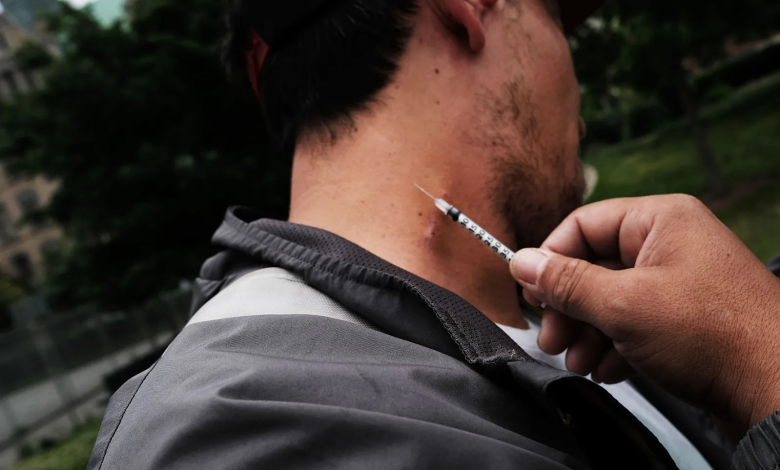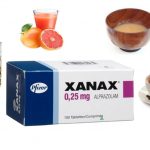Is It Safe to Shoot Up Xanax?

Xanax is a brand of alprazolam, a powerful benzodiazepine that is used to treat anxiety and panic disorders by decreasing abnormal excitement in the brain. The medication comes in the form of a tablet that quickly dissolves in the mouth, an extended-release tablet, or a concentrated oral solution.
Benzodiazepines can have therapeutic anti-anxiety, anti-convulsant, muscle relaxing, and sedative effects.
Alprazolam is among the most prescribed benzodiazepine drugs in the U.S. and is among the benzodiazepines most often found in the illegal market, according to the Drug Enforcement Administration.
Xanax is often prescribed for mental health disorders related to anxiety. It can be used to treat general anxiety, panic disorder, social anxiety disorder, and phobias. It can also be used to treat seizures. For people who suffer from anxiety, it can create a sense of relief to focus on their lives without issues of anxiety or phobias plaguing them. When used as prescribed, it can calm people down and make them feel relaxed.
Xanax can also reduce physiological symptoms of anxiety and fear, such as a racing heart or hyperventilation. These drugs are so often prescribed because they work well on anxiety and they’re cheap.
However, many people use Xanax for nonmedical reasons, taking it in larger doses or more frequently than prescribed because it can create a euphoric feeling, especially at higher doses. Xanax tends to start acting quickly after a person takes it, and the euphoric effects of the drug will usually manifest themselves within about an hour after taking it.
A tendency has grown in some social circles to view Xanax, as a type of “alcohol” in pill form. It’s become socially acceptable among these groups of friends to get together and share Xanax with one another. Of the 30.5 million people who used benzos in 2015, 17.1% misused them. Misusing Xanax or combining it with other substances like alcohol can amplify its effects, but the results can also be deadly.
Along with recreational use, many people rely on Xanax to deal with issues like situational anxiety without having to commit to therapy, which can be expensive and time-consuming. Xanax is popular in America, for example, because there is a tendency for people to love things that are looked at as a quick fix. Xanax isn’t a long-term medication, so some people “take it when they need it” for relief. The temporary relief they feel can help in a fast-paced world with constant exposure to negative world news, stressful jobs, and uncertainty.
How should Xanax be used?
Xanax (alprazolam) comes as a tablet, an extended-release tablet, an orally disintegrating tablet (tablet that dissolves quickly in the mouth), and a concentrated solution (liquid) to take by mouth. The tablet, orally disintegrating tablet and concentrated solution usually are taken two to four times a day. The extended-release tablet is taken once daily, usually in the morning. Follow the directions on your prescription label carefully, and ask your doctor or pharmacist to explain any part you do not understand. Take alprazolam exactly as directed.
To take the concentrated liquid, use only the dropper that came with your prescription. Draw into the dropper the amount prescribed for one dose. Squeeze the dropper contents into a liquid or semisolid food such as water, juice, soda, applesauce, or pudding. Stir the liquid or food gently for a few seconds. The concentrated liquid will blend completely with the food. Drink or eat the entire mixture immediately. Do not store for future use.
Remove the orally disintegrating tablet from the bottle just before it is time for your dose. With dry hands, open the bottle, remove the tablet, and immediately place it on your tongue. The tablet will dissolve and can be swallowed with saliva. The orally disintegrating tablet can be taken with or without water.
Swallow the extended-release tablets whole; do not chew, crush, or break them.
Your doctor will probably start you on a low dose of alprazolam and gradually increase your dose, not more than once every 3 or 4 days.
Can you shoot up Xanax?
No, although Xanax comes in a concentrated solution (liquid) to take by mouth, this type of Xanax should never be injected. Mixing Xanax pills in liquid for injection also comes with deadly consequences.
Xanax is fast-acting, the body absorbs Xanax quickly, so its effects come on rapidly. Within about 1–2 hours, the concentration of Xanax in the blood reaches its peak after taking it orally. Injecting Xanax can cause instant overdose and studies have shown that Xanax is significantly more toxic than other benzodiazepines in cases of overdoses. The likelihood of fatal consequences is increased when large doses of Xanax are combined with alcohol. If an overdose is suspected, immediately call a poison helpline and seek emergency medical care.
Use Xanax as prescribed, and swallow the extended-release tablet or tablet whole with a full glass of water. Do not break, crush, or chew it. If you are using the orally disintegrating tablet, make sure your hands are dry before you handle the tablet. Do not remove the tablets from the bottle until you are ready to take them.
Shooting up Xanax, or injecting it intravenously, is especially hazardous and come with the following dangers:
1. Dose Accuracy: Injecting Xanax makes it difficult to accurately measure the dose, which increases the risk of overdose.
2. Rapid Onset: Injecting a substance provides a much faster onset of effects compared to oral ingestion. This rapid onset can lead to an overwhelming and dangerous level of sedation, respiratory depression, and loss of consciousness.
3. Vein Damage: Repeatedly injecting substances can lead to vein damage, including collapsed veins, infections, and the formation of abscesses.
4. Increased Risk of Infection: Sharing needles or using unsterilized equipment greatly increases the risk of transmitting bloodborne infections such as HIV and hepatitis.
5. Addiction and Withdrawal: Injecting Xanax can lead to a quicker development of physical and psychological dependence, making it extremely challenging to quit and increasing the risk of severe withdrawal symptoms.
6. Mental Health Effects: Injecting Xanax can exacerbate mental health issues, including depression, anxiety, and even suicidal thoughts.
If you or someone you know is struggling with substance abuse, including Xanax or any other drug, it is crucial to seek help immediately from a medical professional or addiction treatment specialist. There are resources and support available to help individuals overcome addiction and regain control of their lives safely.





